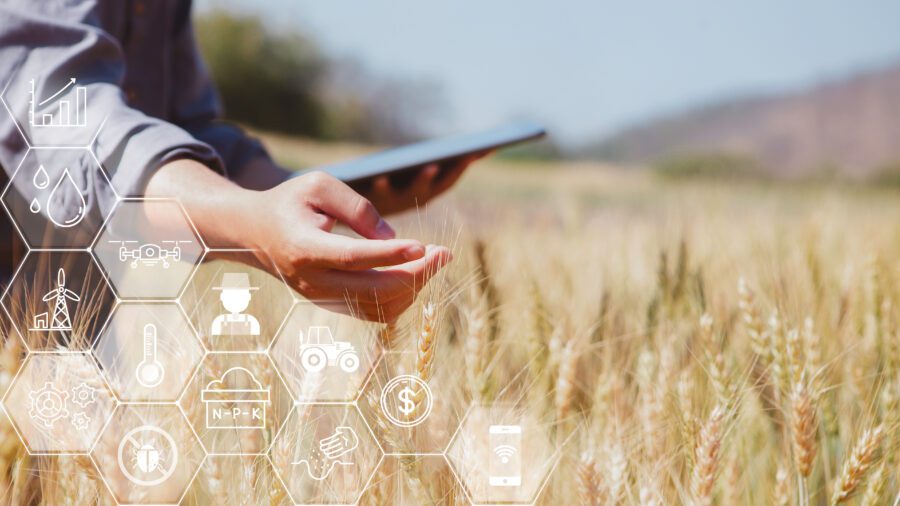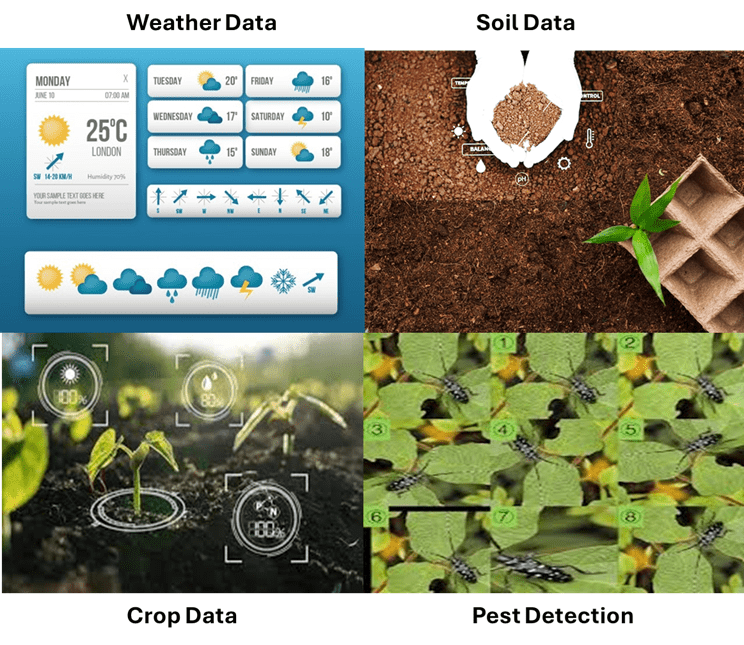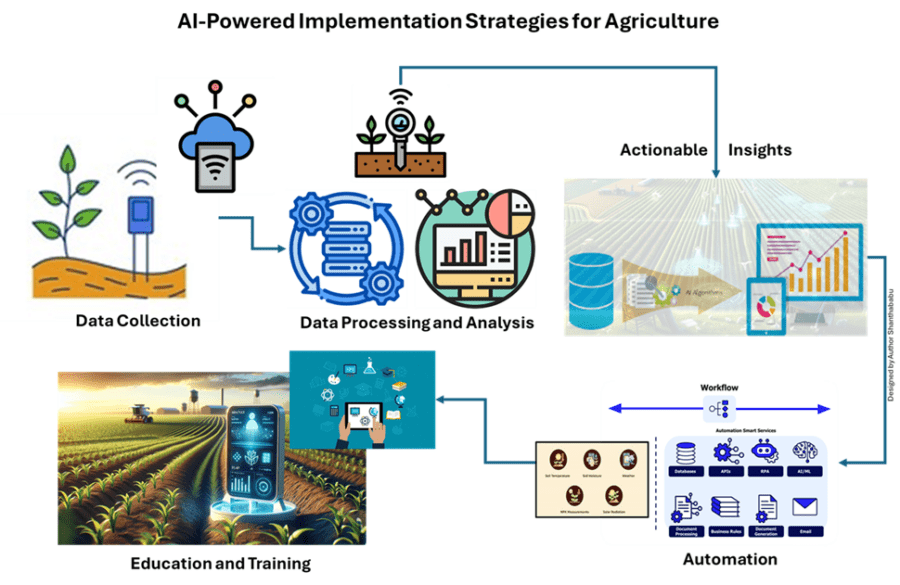
Introduction
By embracing AI-powered precision agriculture, the farming sector can navigate the challenges of climate change, ensuring sustainable food production for future generations.
Agriculture is the backbone of global food security, yet it faces unprecedented challenges due to climate change. Rising temperatures, erratic rainfall patterns, soil degradation, and pest outbreaks threaten crop yields and livelihoods. Precision agriculture, powered by Artificial Intelligence (AI), offers a sustainable and innovative solution to these challenges, transforming farming practices with data-driven insights and automation
Climate change poses significant challenges to agriculture, including unpredictable weather patterns, soil degradation, and pest outbreaks. Precision agriculture, powered by Artificial Intelligence (AI), offers a sustainable solution by optimizing farming practices through data-driven insights. By leveraging AI, farmers can enhance productivity, improve resource efficiency, and ensure crop resilience under changing climatic conditions
Functional aspects of AI in precision agriculture
AI utilizes advanced machine learning algorithms to analyze vast datasets, including:
- Soil Data: AI examines soil composition, pH, moisture levels, and nutrient availability to recommend optimized fertilization strategies.
- Weather Data: AI integrates real-time weather forecasts to guide irrigation and planting schedules.
- Crop Data: AI monitors crop health using satellite imagery and IoT sensors, detecting diseases or nutrient deficiencies early.
- Pest Detection: AI systems can analyze pest patterns and predict outbreaks, enabling timely interventions.

Benefits of AI-powered precision agriculture
- Resource Optimization: AI minimizes water and fertilizer use by targeting specific areas needing attention.
- Increased Yields: Data-driven insights enhance crop performance, even in adverse conditions.
- Cost Reduction: Efficient resource use and early disease detection reduce input costs.
- Environmental Sustainability: Reduced waste and optimized inputs minimize the ecological footprint of farming.
- Climate Resilience: AI enables farmers to adapt to climate variability through predictive analytics.
- Enhanced Decision-Making: Real-time insights empower farmers to make informed decisions, improving operational efficiency.
Challenges in implementation
- Data Availability: Limited access to quality datasets in rural areas.
- Technical Barriers: Lack of expertise in AI and machine learning among farmers.
- Infrastructure Needs: Dependence on IoT devices and connectivity.
- Cost: High initial investment for AI tools and infrastructure.
- Data Privacy: Concerns over sharing proprietary farm data.
- Adoption Resistance: Farmers may be hesitant to adopt new technologies due to unfamiliarity.
Implementation strategies
Step 1: Data Collection
- Deploy IoT sensors to monitor soil, weather, and crop health.
- Use satellite imagery for large-scale monitoring.
Step 2: Data Processing and Analysis
- Use machine learning algorithms to analyze collected data.
- Implement predictive models to guide decisions on irrigation, fertilization, and pest control.
Step 3: Actionable Insights
- Deliver recommendations to farmers via user-friendly mobile apps or dashboards.
Step 4: Automation
- Integrate AI with automated systems, such as smart irrigation or autonomous tractors, for real-time action.
Step 5: Education and Training Conduct workshops and training programs to familiarize farmers with AI technologies and their benefits

Sample Implementation Code for Machine Learning and Data Analysis
Here’s an example using Python to predict crop yields based on soil and weather data:
import pandas as pd
from sklearn.model_selection import train_test_split
from sklearn.ensemble import RandomForestRegressor
from sklearn.metrics import mean_squared_error
Load dataset
data = pd.read_csv(“crop_data.csv”)
Preprocessing
X = data[[‘soil_moisture’, ‘temperature’, ‘rainfall’, ‘fertilizer_level’]]
y = data[‘crop_yield’]
Train-test split
X_train, X_test, y_train, y_test = train_test_split(X, y, test_size=0.2, random_state=42)
Model training
model = RandomForestRegressor(random_state=42)
model.fit(X_train, y_train)
Predictions
y_pred = model.predict(X_test)
Evaluation
mse = mean_squared_error(y_test, y_pred)
print(f”Mean Squared Error: {mse}”)
Feature Importance
importance = model.feature_importances_
for i, col in enumerate(X.columns):
print(f”{col}: {importance[i]:.2f}”)
Real-world applications
- John Deere: Develops AI-driven equipment for precision planting and fertilization.
- IBM Watson Decision Platform for Agriculture: Offers predictive analytics for weather and crop management.
- Blue River Technology: Uses AI-powered robotics for precision weed control.
- CropIn: Provides AI-based solutions for monitoring farm conditions and improving productivity.
- Microsoft Azure FarmBeats: Utilizes AI and IoT for actionable agricultural insights.
Conclusion
AI-powered precision agriculture offers a sustainable path forward in addressing the dual challenges of climate change and food security. By optimizing resources, enhancing productivity, and building resilience, AI empowers farmers to adopt environmentally friendly practices while securing livelihoods. As technology continues to evolve, the widespread adoption of AI in agriculture has the potential to revolutionize the sector, ensuring a sustainable and resilient future for global farming.
AI in precision agriculture will continue to evolve with advancements in machine learning, IoT, and cloud computing. Integrating blockchain for data security and transparency will further strengthen its adoption. Emerging technologies like edge computing will enable faster processing of data directly on farms, enhancing real-time decision-making capabilities.

yes sir, i have also planned this kind of project which can use previous data as some expirience farmers had and help to predict what should be the further decisions and i think this will attract to the new generation farmers who can be easily educated.